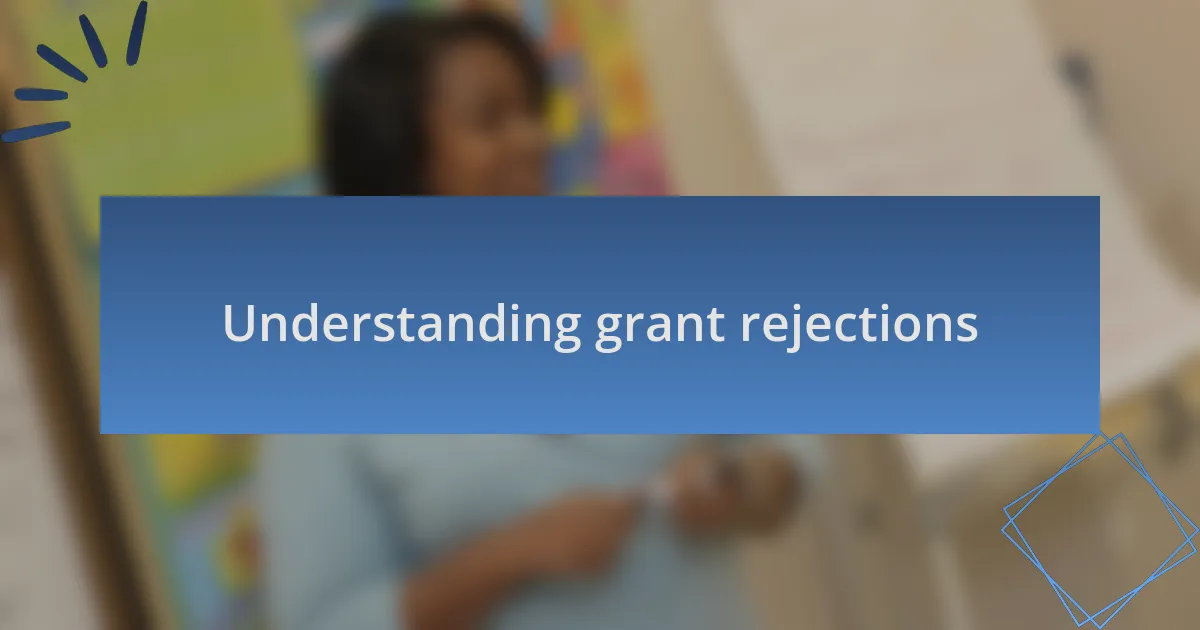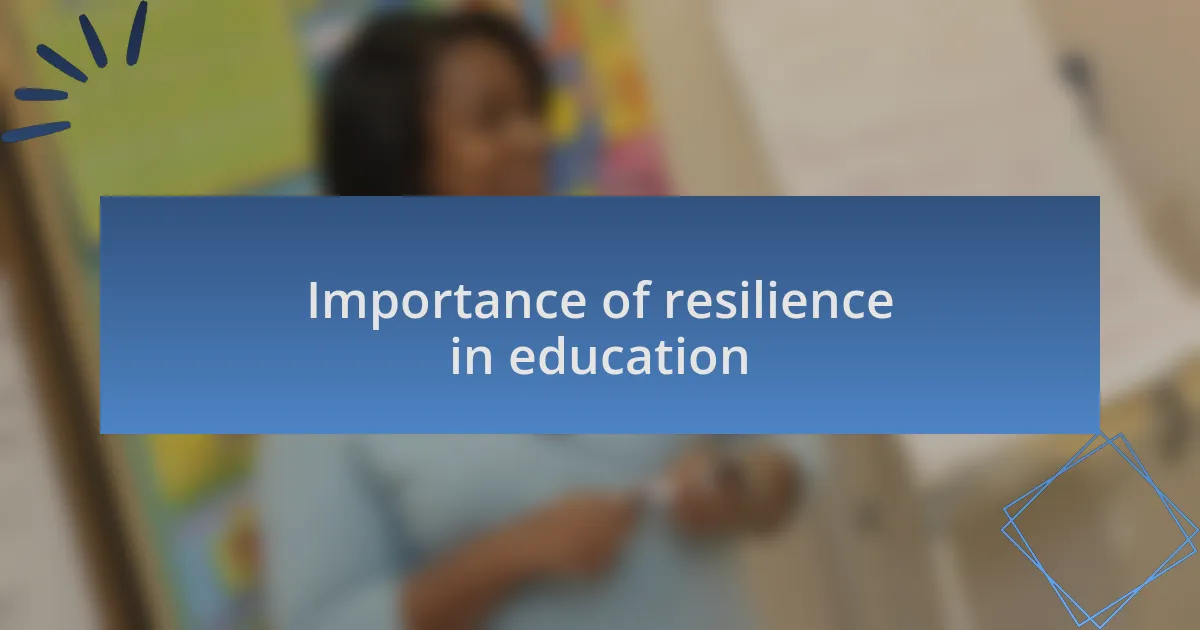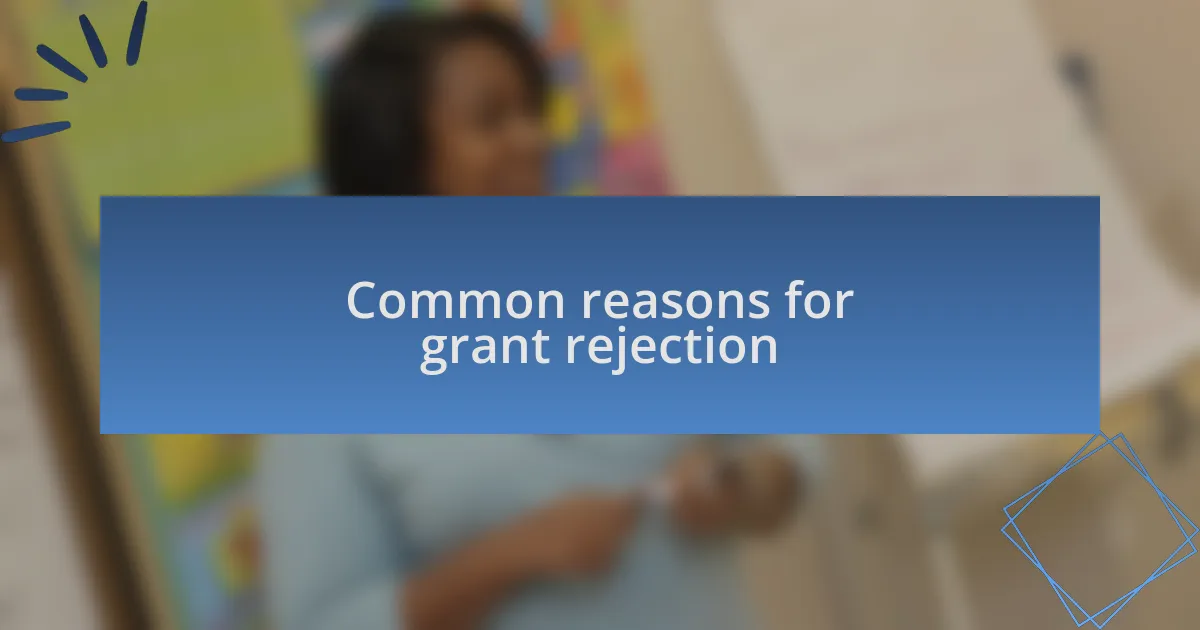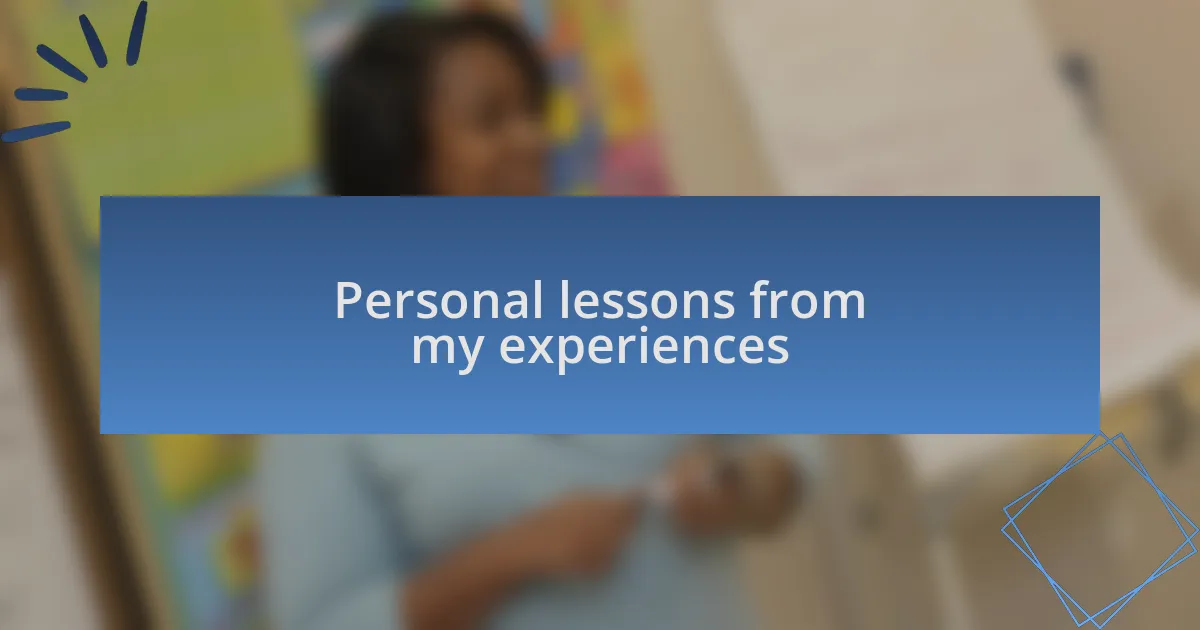Key takeaways:
- Grant rejections are valuable learning opportunities, prompting refinement of proposals and methodologies.
- Resilience is crucial in education, fostering collaboration and creativity through shared experiences of failure.
- Clear communication, realistic budgeting, and alignment with funder goals are key to successful grant applications.
- Embracing feedback and storytelling can transform proposals by making them more impactful and relatable.

Understanding grant rejections
Grant rejections are often viewed as a significant blow, but I’ve come to see them as essential stepping stones in the learning process. When I received my first rejection, I felt a mix of disappointment and confusion. Why didn’t they see the potential in my project? It took time to realize that each rejection was an opportunity to refine my ideas and improve my proposals.
Understanding the reasons behind a rejection can be enlightening. For instance, I once received feedback that my methodology lacked clarity, which prompted me to revisit and enhance that aspect. It was a humbling experience, but I learned that constructive criticism, though hard to swallow at times, is often the key to moving forward. How often do we overlook this valuable input?
I’ve also noticed that grant committees tend to favor projects that align closely with their specific goals and priorities. After a few rejections, I began researching each funder’s mission in detail, which changed my approach entirely. I can’t help but wonder—what if I had done that from the start? It taught me to tailor my proposals and truly connect my work to the funder’s vision, leading to much greater clarity and focus in my applications.

Importance of resilience in education
Resilience in education is not just about bouncing back from setbacks; it’s about developing a mindset that thrives in adversity. I remember a particularly tough semester when I struggled with my coursework and felt overwhelmed. Instead of retreating into self-doubt, I acknowledged my challenges and sought help from my professors and peers. This experience not only improved my academic performance but solidified my belief in the power of perseverance.
I’ve come to realize that resilience fuels creativity and innovation. When I faced repeated rejections for a research proposal, it pushed me to think outside the box and explore unconventional solutions. Each attempt taught me to adapt and refine my approach, igniting a passion I hadn’t tapped into before. Isn’t it fascinating how obstacles can lead us to unexpected discoveries?
Moreover, resilience fosters a collaborative spirit in the educational environment. I’ve learned that sharing experiences of failure with classmates can create a supportive community where we uplift one another. By discussing our setbacks openly, I found common ground with others who felt similarly, reinforcing the idea that we’re all in this together. This sense of shared resilience not only enhances individual growth but cultivates a culture that values learning through experience.

Common reasons for grant rejection
When reviewing grant applications, I’ve observed that a lack of clarity in the proposal is a significant red flag for reviewers. In my own experiences, I’ve submitted proposals that were too technical or vague, leaving readers puzzled about the core objectives. It’s crucial to communicate your vision clearly; if the reviewers can’t easily grasp your goals, they will likely hesitate to invest in your project.
Another common reason for grant rejection stems from unrealistic budgets. I learned this the hard way after presenting a proposal that included inflated costs, underestimating the scrutiny of funding bodies. If a budget doesn’t align with the proposed outcomes or seems extravagant, it raises eyebrows and questions of credibility. Was I really serious about the financial aspects of my project? Crafting a realistic and justifiable budget not only shows respect for the funding organization but also demonstrates professionalism.
Additionally, I’ve seen projects get denied when they lack connection to the funding body’s mission. Once, I pursued a grant that had specific goals and values that didn’t quite align with my project focus. By neglecting to connect my objectives with the funding body’s priorities, I missed a crucial opportunity. It’s essential to demonstrate how your idea aligns with their mission; otherwise, your application may not resonate with decision-makers.

Strategies to improve future applications
When I started to rethink my grant applications, one crucial strategy emerged: seeking feedback from peers. After another rejection, I reached out to a trusted colleague and asked for their thoughts on my proposal. Their fresh perspective revealed areas of confusion that I had overlooked. Have you ever had that moment when someone points out the obvious, yet you just couldn’t see it? Embracing constructive criticism can turn a good proposal into a great one.
Another strategy that proved invaluable was creating a clear timeline for every phase of my project. In previous applications, I hadn’t realized how vital it was to show that I had a well-thought-out plan for implementation. I remember a proposal where I included vague milestones. That left reviewers questioning how I would manage the project. By providing a detailed timeline with specific objectives and deadlines, you convey to the funders that you’re organized and capable of delivering results.
Lastly, I learned the importance of storytelling in crafting a compelling narrative. When my proposals fell flat, they often felt like a list of facts rather than a vibrant description of the impact my project could have. Sharing personal experiences related to the project can create a connection with reviewers. Does your story resonate with your mission? It did for me once I shifted my focus from mere objectives to the lives my project could transform. By weaving in personal anecdotes, I was able to evoke emotions that not only engaged readers but also enticed them to imagine the potential outcomes of my work.

Personal lessons from my experiences
Reflecting on my grant rejections, one lesson stands out: resilience is key. I remember sitting in front of my computer, staring at yet another rejection email, feeling a mix of disappointment and despair. In those moments, I had to remind myself that each setback wasn’t a reflection of my worth or abilities. Instead, they were opportunities—stumbling blocks that taught me to pick myself up and keep moving forward.
Another insight I gained was the power of persistence. There was a time when I submitted a proposal that I believed in wholeheartedly, only to receive a swift rejection. Rather than giving up, I decided to revisit my idea, refine it, and submit again. That second round of applications opened doors I didn’t even know existed. Have you ever found that your best ideas emerge only after the initial setback? For me, it was in those quieter moments of reflection that I discovered the real potential of my work.
Lastly, I’ve learned that vulnerability can create stronger connections. I recall sharing a personal story about my journey in one proposal, detailing why the project mattered to me on a personal level. The response was overwhelmingly positive. The reviewers didn’t just see the project; they felt my passion and commitment. This taught me that authenticity not only builds credibility but also resonates deeply with those reading your work. How often do we forget that our stories are what truly humanize our proposals?

Turning rejection into opportunity
Turning rejection into opportunity often requires a shift in perspective. I remember receiving a particularly disheartening email; it felt like my world had been turned upside down. However, as I reflected on that moment, I realized it was a chance to reassess my goals and priorities. That rejection compelled me to think critically about what I truly wanted to achieve and how I could navigate my path forward.
What surprised me was how the rejections nudged me toward collaboration. After a few setbacks, I reached out to peers to seek feedback on my work. It was a game-changer! Their insights helped me see angles I had previously overlooked, ultimately leading to a more robust proposal. Have you ever thought about how inviting others into your journey might amplify your efforts? I learned that sharing challenges not only fosters growth; it also strengthens bonds within the community.
Each rejection became a catalyst for growth, pushing me to explore areas I had never considered. I recall reworking my rejected proposal into a new project focused on social impact, which garnered a favorable response from a different funder. This experience taught me that sometimes, the seeds of our best ideas are hidden in the soil of disappointment. How often do we overlook the silver linings hiding in plain sight?